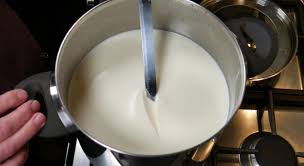
Coagulants and Rennet:
Coagulants can be more than one type and are used to separate the milk into two halves-curds and whey. Naturally, this separation can happen even with no rennet due to acidification of the yogurt and kefir; however, the acidic level can be too high and take time. The lemon juice, vinegar and citric acid can coagulate the milk without rennet but frequently work best with hot milk.
The use of rennet allows separating the milk before the acidification of the milk is too high and helps form hard curds and can be used at moderate milk temperature for an extended time. In other words the taste will be milder
Naturally, the rennet is made from the calf’s stomach. And the traditional recipe is as follows:
Dried and cleaned stomachs of a young calf, kid or lamb are sliced into small pieces and then put into salt water or whey, together with some vinegar or wine to lower the pH of the solution. The rennet mix is filtered after some time (overnight or several days). The crude rennet that remains in the filtered solution can then be used to thicken the milk. About 1 g of this solution can normally coagulate 2 to 4 L of milk.
This is not the only one of the Rennet types. There is also microbial rennet, an enzyme extracted from fungi and suitable for vegetarians.
There is also vegetable rennet, and in the past yellow bedstraw plant, thistles and nettles. Cardoon and fig sap can also be used, but they can deliver a bitter taste to the cheese, so you must be careful when used.
The recombinant rennet is the next rennet type. It is artificially fermented chymosin, considered vegetarian. Still, it is not recognised as an organic product because the GMO technique was used.
In most cases, the rennet is added an hour or three after the starter cultures when the milk starts slightly to sour. Other cheesemakers add it together with the starter cultures, which work fine for small quantities of milk.
The different cheeses require an additional amount of rennet. Frequently the rennet must be diluted in water before adding it to the milk. It can be made as liquid, tablets, powder or rennet paste.
The speed of the coagulation depends on the following:
The particular animal: Sheep’s and Buffalo’s milk thicken quicker than cow’s milk. The goats’ milk coagulates slower than any of the mentioned kinds of milk.
PH: Lower PH, which occurs after acidification, increases coagulation speed.
Temperature: lower temperature reduces the speed or prevents it at all.
A temperature of up to 45C increases the speed of coagulation.
Protein content:
Rich in protein, milk speeds up the thickening.
Calcium/Calcium chloride:
Pasteurisation and homogenisation change the structure of milk, removing some of the calcium and destabilising it slightly. When using any milk that is not raw milk to make cheese, add calcium chloride to increase the number of available calcium and help firm up the curds. Calcium chloride is added to the milk before the coagulant. Then added to the milk, it increases the yield and thickens the curd, reducing coagulation time. But it can lock moisture in the cheese and spoil the aged cheeses.
However, the fresh Cheeses are just fine, although they would not last long outside the fridge.